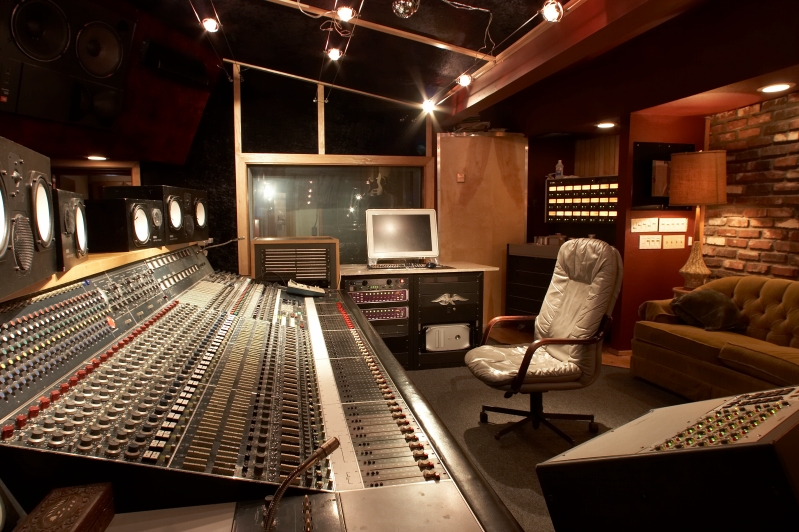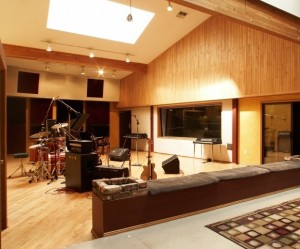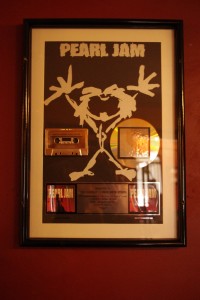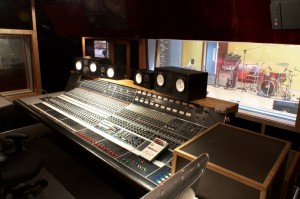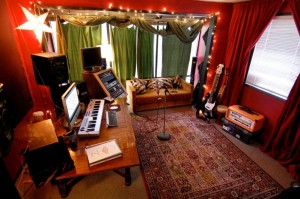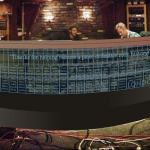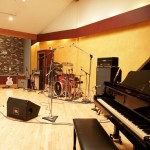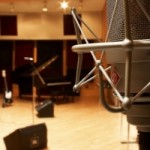London Bridge Studios: Neves, Studers, and Living History
In 2005, and, with the weight of their purchase heavy on their minds, Jonathan Plum and Geoff Ott painted the walls of their newly acquired studio, London Bridge.
By then, London Bridge Studios had already seen plenty of history pass within its walls—Pearl Jam’s Ten, Soundgarden’s Louder Than Love, and Alice In Chains’ Facelift were all recorded there—but “history” would not pay the bills on a 5,000 square foot studio space just north of Seattle.
Previous owner and co-founder, Rick Parashar, had been riding high in 1991, working behind the board for Pearl Jam’s Ten in what was then his private studio. By the mid 2000s, business was sporadic and Parashar sought to get out altogether. He chose not to renew on his 10-year lease. London Bridge was to be gutted and turned into a carpet warehouse; all that history buried under mountains of shag and Saxony.
Before the deal was through, Parashar asked his former assistant, Plum, if he and his current partner Ott might want to buy the studio instead. Plum and Ott scraped together what money they could. “We wondered ‘What does a studio cost?’” says Plum. “It didn’t really matter, because we could only get so much money. So we came back and said ‘This is what we got’. It was a bit of a fiasco, but it worked out.”
Months later, they were painting the walls of their new (old) studio when a young musician named Eric Lilavois walked in their front door. His band’s Canadian tour had just been cancelled; could Plum and Ott record an album with the money his band had left over?
The painters put their brushes down, and thus began London Bridge’s second life. Almost a decade later, Lilavois—the studio’s first new client—would become its third owner.
In On the Ground Floor
From the outside, London Bridge could definitely pass as a carpet warehouse. It sits, unmarked, at the back of a run-of-the-mill office park. Through a glass front door I see a logo marked with the letters “LBS”, and decide this is either the studio, or some kind of totally unrelated not-for-profit foundation.
Studio manager Carson Lehman greets me in the lobby, which doubles as a kind of lounge. Lehman has worked for London Bridge for just over a year, following six years in Los Angeles at Kingside Sound Lab.
“By the time I left LA, I was really kind of burnt out on studio life,” he later tells me.
“I thought I was going to come up here and get a job at Amazon or something. I took a few months off, then sent out maybe 3 resumes, and this is one of the studios I knew from growing up. As soon as I walked through the door it felt like home. It felt like what I thought a studio would be like from the time I went to audio school.”
As we head in to the studio, we walk by a pool table, a foosball table, an authentic Donkey Kong arcade game, and a few black leather couches. One wall of the lounge holds the studio’s many gold and platinum album certifications. Another wall holds haphazardly slapped-up band memorabilia: promotional and candid photos, random notes, some belonging to the artists from the other wall, others belonging to bands that time forgot.
Today the live room is empty, save for a few keyboards against the walls, a Wurlitzer, and a Yamaha C7 grand piano. On one end of the long room is an exposed brick wall. The opposite wall is heavily treated with acoustic padding. Listening back to the recordings of Lehman and I speaking, I can hear the reverb around our voices change as we move from one end of the room to the other.
“The main room was designed to have as much flexibility as possible,” Lehman says.
“It’s divided into three different areas. [The dampened side] is a little more controlled; you get more of a deadened sound. It progresses until you get up against the brick wall and everything just kind of explodes. The sounds get huge. On the bulk of the rock and roll albums we do, we’ll toss the drums up there and that’s how we get these massive drums that still sound controlled.”
My mind flashes back to seventh grade, with Dave Krusen’s drums on Ten blasting through my Walkman’s headphones. At the time, it sounded to me like he was playing in the middle of an empty warehouse. “I’ve never seen drummers more motivated to set up their drums and tune them,” Lehman says, smiling.
“We also have classical musicians who come in, and if we have a two-piece, they’re going to set up in the middle of the room and love it. They’re listening for something completely different than a rock band that comes in here.”
French doors connect the main room to a vocal booth. Lehman points out the clean sight-lines to the main room, allowing singers to see the band, or horn players to see a conductor.
Geoff Tuner, who also designed Vancouver, BC’s Little Mountain Studios, laid out the blueprints for London Bridge in 1985. With few exceptions, the ground floor has changed very little on a structural level since it was first built. But next to the vocal booth is an overdub booth that Plum and Ott have modified—slightly.
“Jonathan and Geoff put a lot of work into clamping down the side room, so that you can also get dead Strokes-like drum sounds,” says Lehman. “It’s very controlled. You could get a dead drum sound out in the main room, but it would take a few hours. The side room is built for it.”
Finally, we visit the control room, and London Bridge’s crown jewel: The Neve 8048 console. “This was built in 1974 by Rupert Neve. In terms of actual consoles it’s one of maybe three or four in the world,” says Lehman.
The Neve is currently undergoing a massive restoration. The studio sends off its 1081 mic pres five at a time for overhaul. Components are rebuilt and acid-washed to get them as close to what came off the original assembly line as possible. Finally, two men from Vintage King—the vintage audio gear reseller—will fly out and rewire the whole board over a two-week period.
“Within the industry, they are stoked about having a Neve in that state totally restored,” says Lehman. “For us, this is London Bridge—it’s as much a part of our workflow as it is a historic thing, as it is an asset that will bring people to the studio to work on it. Jonathan [Plum] came up on this board since he was 19; it’s been here more than half his life.”
Off in a corner of the control room is a Studer A-800 MKIII 24-track 2-inch tape machine, one of Plum’s favorite pieces of gear, and one that just barely survived the transition in ownership.
“Rick was remodeling and he wanted to get the Studer out of here,” says Plum. “The remote cables ran underneath the floor and Rick couldn’t pull it out, so he literally cut the cables. Geoff tried to stop him, but Rick said ‘I don’t have time’ and just snipped it.”
After purchasing the studio, restoring and rewiring the Studer was one of Plum and Ott’s top priorities. “Now we can be going to tape within five minutes,” says Carson Lehman. “Being able to trust this stuff to be calibrated and working properly is unique,” he says with what seems like only slight embellishment.
Plum would add the studio’s construction to that category as well: “Unlike some other studios in Seattle that were built from existing buildings, this place was planned from the ground up and it was built really well,” he says.
“The isolation between the rooms, the sound in the control room, the sound of the drum room. I think it’s world class. And it’s super inspiring to work on projects that were recorded in that room because it sounds fucking rad. I’ve always struggled in other spaces: ‘Does this sound to me like what a record sounds like?’ Recording in that room sounds like a record.”
Three’s Company
Plum can only join us for a portion of the tour. He’s in and out of his workspace upstairs, working frantically to finish up some mixes before leaving town in a few days.
“I always seem to have a record or two happening, but that’s another difference between today and back in the day,” he says. “Then, it was ‘Let’s book a studio for the week and make a record.’ Now it’s like: ‘Let’s book one day downstairs, then over the next two months let’s work upstairs on weekends’. I’ve worked on some records for over 2 years. I kind of like doing it both ways. Short bursts are good for spontaneity, but longer projects also give you time to step back.”
Plum passes by his partner Ott, who is coming from mixing a project in his own office, in the upstairs common area. They say a few words to each other, then both return to their mixes.
Plum works in ProTools while Ott prefers the more recently added PreSonus Studio One. Carson Lehman shows me the wooden box that houses Ott’s computer. “He just has to detach that and bring a monitor and he can float anywhere,” Lehman says.
“With this Orion 32 interface, he has the ability to have 32 ins and outs, so he can hook this up in any studio and have access to the majority of it. Sometimes it’s as simple as working downstairs and then coming upstairs. And sometimes Geoff mixes in Nashville and LA. It’s what the modern workflow dictates.”
London Bridge’s third partner, Eric Lilavois, is currently in Los Angeles, where he is also owner of Crown City Studios. When Lilavois is in town, Carson Lehman is the man in the middle, juggling studio time for all three producers. “The calendar is first-come first-serve, but if there’s something with high priority, there’s also flexibility.”
Jonathan Plum and Geoff Ott’s relationship spans more than 20 years. When Plum left his engineering position in 2000, after 10 years with Rick Parashar, he and Ott had built a smaller studio together in downtown Seattle, working there for several years before coming back to purchase London Bridge. (Their studio space was taken over by Matt Bayles and was called The Red Room, before he too eventually relocated.)
Eric Lilavois has also had a long relationship with Geoff Ott. “Geoff is Eric’s mixer when the band has the money,” says Carson Lehman. “They’ve worked together a lot. Geoff will sometimes fly down to Los Angeles and mix at Crown City”.
This kind of intermingling and collaboration extends past the studio and into to the trio’s latest endeavor: London Tone Records.
“The idea behind the label was to have the bands that we want to record, but who really can’t afford it, do it but with a good reason to do it,” says Jonathan Plum. “We have this downtime half the time. What do we do with it? Bands are like ‘Can we get in there for free on your down time?’ Yeah, we’ll record your song, but you have to give us half the publishing.”
Plum, Ott, and Lilavois make mutual decisions on which bands to feature on the label. They are currently in the middle of an ambitious project to release one single recorded at London Bridge by a different group, each week this year.
“It took us a couple of years to plan this out,” Plum says of the marathon 52-week recording-and-release schedule. “Monetarily, it’s not doing much, but it puts the studio name out there.”
In the new economy, just putting London Bridge’s name out there is a bigger part of the job than it’s ever been.
From Private to (Very) Public
In its first 20 years, London Bridge hosted some of the biggest rock bands of the day (past clients also include Blind Melon, Candlebox, and Three Doors Down) but it remained closed to the public.
When Jonathan Plum first threw open the doors to the wider world, he “honestly thought it would be a lot easier to sell. I knew every producer in town, I offered them a free day at first. Over the first year, we got a lot of people out here, but it didn’t stick. People are set in their habits.”
With the help of a PR professional, Plum and Ott were eventually able to reinvent London Bridge for a new clientele. The studio’s most recent decade has featured recordings by Death Cab for Cutie, Fleet Foxes, Blake Lewis, Queensryche, and in 2006, an official orchestral recording of the Monday Night Football theme “Heavy Action”.
Today, London Bridge has a symbiotic relationship with the community. You can throw a party there, or take a Pro Tools lesson, or transfer your analog tape to digital format, or take a historic tour (I got mine for free).
“The historic tours began with people literally showing up in the middle of the day, middle of a session, just walking in the door,” says Carson Lehman. “We still get that every once in a while. I tell my interns to come out here every 15 minutes to just keep a presence and make sure that’s not happening.”
You can also help restore the Neve board by donating to the studio’s Indiegogo campaign, or attending a benefit show planned for the near future.
“The Neve campaign plays into the story of what’s happening to the modern day studio,” says Plum. “Studios like this are either funded by an outside source or they’re closing. We’re doing fine. It’s never been super easy, but we’re getting by. Rates keep going down, though, and the money isn’t there to repair the board as it’s breaking down. Asking the community for help is a new thing in our industry.”
Plum may have to hustle for business in a way Rick Parashar never did. He may have to jockey for studio time with two other partners, not to mention other producers from outside the studio. He may have to take on multiple open-ended projects at once and open the studio doors to the public wider than they’ve ever been before, but this is what’s been necessary to bring the studio back from the brink for a second act. London Bridge almost died once. Plum and his colleagues aren’t about to let it come that close again.
“London Bridge is one of the few studios I know that has strictly been a music recording studio the whole time,” he says. “We’ve only made our money recording bands, and I think it shows in the way we handle bands. The only way we keep people coming here is with enthusiasm and passion.”
Blake Madden is a musician and author who lives in Seattle.
- Neve under restoration
- Another view of the London Bridge Live Room
- Some of the instruments and amps at London Bridge Studios
- London Bridge Control Room
- Drums all mic’d up for Mom’s Rocket
- The “Dub Room” at London Bridge
- Another view of the London Bridge Live Room
- Studio A Lounge
- The Neve 8048 at London Bridge
Please note: When you buy products through links on this page, we may earn an affiliate commission.







